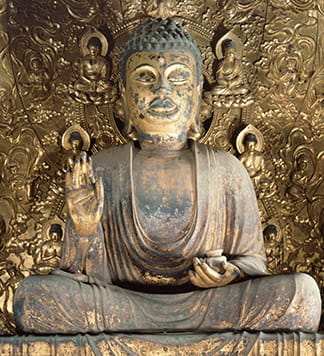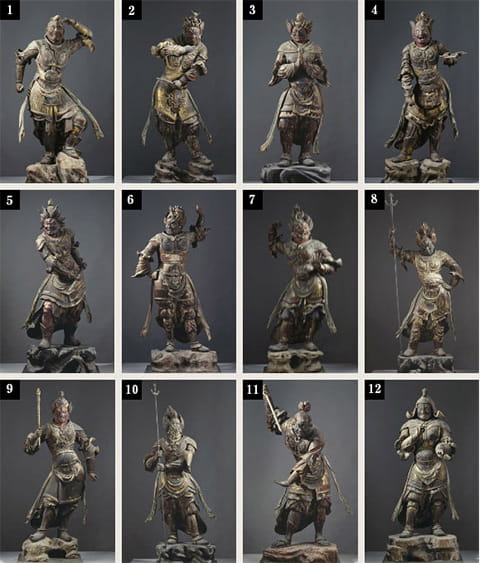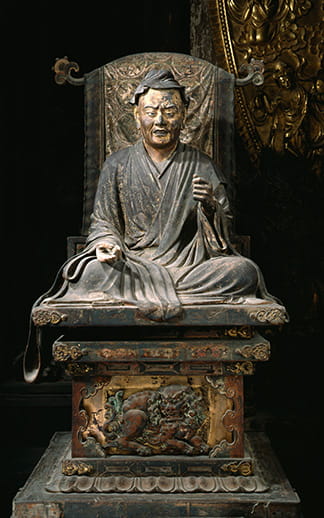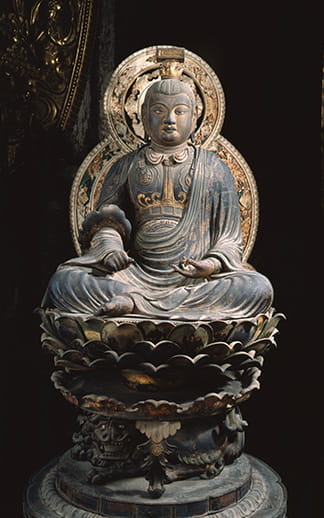Eastern Golden Hall National Treasure
Yakushi Nyorai (Important Cultural Property)

Yakushi Nyorai (Skt. Bhaiṣajyaguru), literally the “Buddha Master of Medicine,” resides in a pure land known as the Pure Beryl Radiance Realm that is said to be located far to the east of our world system. As his name implies, Yakushi is especially associated with the curing of illness and the prolonging of life. In addition, he leads beings who have gone astray back to the correct spiritual path, and protects them during their religious practice.
The principal icon of the Eastern Golden Hall, the image is seated in full lotus position with the lower robes draped down over the edge of a high rectangular throne. The left hand rests on the left knee holding a medicine jar, while the right hand is bent at the elbow with the palm facing outward and the fingers extended in the gesture of dispelling fear (semui-in).
The current icon was made out of copper alloy using a clay piece-mold casting technique. It was constructed after the previous image (itself a replacement for the Nara-period original) was lost to fire in 1411, and installed as the principal icon of the of the Eastern Golden Hall in 1415.
During repairs to the building in 1937, the head of the previous image, a statue cast in 685 and moved to Kohfukuji from Yamadadera Temple in Asuka, was discovered inside the box-shaped throne of the current icon. This rediscovered head, which has been designated a National Treasure as an outstanding example of Hakuhō-era (latter half of seventh century to early eight century) Buddhist statuary, is now on display in the Kohfukuji National Treasure Hall.
Twelve Heavenly Generals (National Treasures)

These highly realistic, powerful sculptures depict the Twelve Heavenly Generals, retainers to Yakushi Nyorai, the Buddha Master of Medicine. As guardians, they are charged with protecting the faithful from illness and harm. Their armor, weapons, and fierce facial expressions are intended to intimidate the foes of Buddhism, and encourage sentient beings to forsake unwholesome actions. As a group, they symbolize the 12 great vows of Yakushi, meaning that they are, in fact, wrathful emanations of the Buddha himself. The head of each of the generals is adorned with one of the twelve animals of the Chinese zodiac.
The images were carved from blocks of Japanese Cypress (Hinoki), and date to around the year 1207. Although the sculptor’s identity is uncertain, it is likely they were made by members of the workshop of Jōkei. Since each of the 12 sculptures differs somewhat from the others in terms of style and technique, a different artist may have carved each one. The vigorous and dramatic sense of movement expressed by this set of images makes them particularly fine examples of the Buddhist sculpture of the Kamakura period (1185–1333).
Yuima Koji(National Treasure)

The “Layman Vimalakīrti” (Yuima Koji in Japanese) is the central character of the Sutra Spoken by Vimalakīrti, a seminal text of the Mahāyāna Buddhist tradition and a foundational scripture for Kohfukuji Temple, whose name derives from a passage of the sutra. According to this scripture, Yuima attained the highest levels of insight without abandoning the life of the householder, and bested all of the greatest disciples in the Buddha’s retinue in debate. His final opponent was Monju (Skt. Mañjuśrī), the personification of Buddhist wisdom. The debate between these two great figures is one of the most dramatic passages in the entire Buddhist canon, and a frequent motif in Buddhist art. The image of Yuima Koji is part of this tradition, as it forms a pair with an image of Monju that is placed on the other side of the central icon.
According to an inscription inside the sculpture, it was carved in 1196 over a period of 53 days by the sculptor Jōkei, following which the painter Kōen spent an additional 50 days decorating it.
It depicts Yuima as an old man wracked with illness and weakened by old age. He sits in the full lotus position on a rectangular pedestal decorated with a relief carving of lions and peonies. Behind him stands a screen resembling a wooden rack with fabric draped over it. Yuima wears a soft cloth cap on his head, and a sash over plain robes. His left hand is held in a fist at chest height, while the right rests on his knee with the palm facing up and the index and middle fingers extended. Since it was meant to depict a real person rather than a Buddha or celestial being, this statue is an exceptional example of the new, highly realistic styles of Buddhist portraiture that were being imported from China and put to use by Nara-based sculptors during the early Kamakura Period (1185–1333).
Monju Bosatsu(National Treasure)

Monju (Skt. Mañjuśrī) is one of the great Bodhisattvas of the Mahāyāna Buddhist tradition. As the personification of wisdom, he represents the Buddhist teaching (Skt. Dharma) and serves as the protector of the scriptures that convey and express this teaching. Due to his association with learning and knowledge, the Monju of the Eastern Golden Hall has been revered by generations of Kohfukuji scholar-monks as their patron Bodhisattva. Today, students come from all over Japan to pray to the image for help in passing their high school and university entrance examinations.
Scholars believe this statue was carved in the last decade of the twelfth century by a sculptor of the Kei School, possibly Jōkei. It is made of blocks of Japanese cypress wood using the sculpting technique known as yosegi zukuri, and features inlaid crystal eyes, applied pigments, and exquisite gilding.
The image rests on a lotus throne with a lion curled up beneath it. Monju is portrayed sitting in half-lotus position in front of a mandorla shaped like two medallions, and wears a cuirass with a robe draped over it. Although the rich, and once-colorful decoration of the robe and armor evoke the style of the late Heian period (794–1185), the overall appearance of the image is based on models imported from Song-dynasty China during the twelfth century. The face is that of a clever, slightly plump boy, while the head is crowned with a topknot on which rests an Indian-style book, a reference to Monju’s role as the protector and transmitter of the Buddhist teachings.

